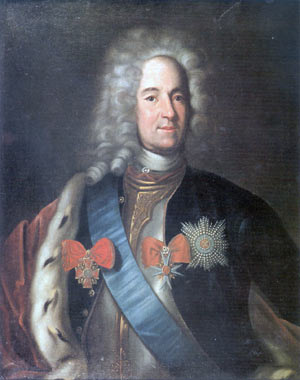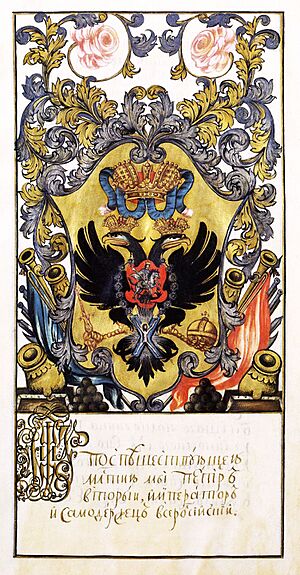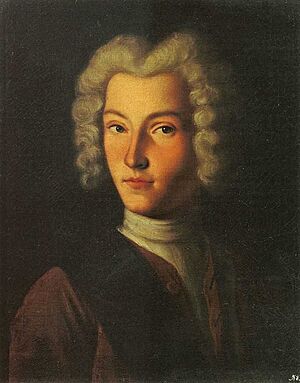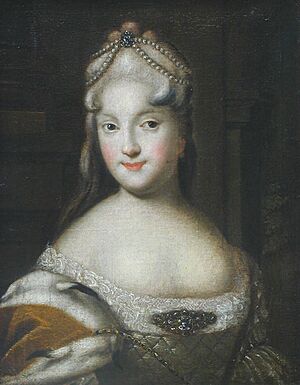Peter II of Russia facts for kids
Quick facts for kids Peter II |
|||||
|---|---|---|---|---|---|

Peter II in armor
|
|||||
| Emperor of Russia | |||||
| Reign | 17 (6) May 1727 – 30 (19) January 1730 | ||||
| Coronation | 25 February (7 March) 1728 | ||||
| Predecessor | Catherine I | ||||
| Successor | Anna | ||||
| Born | 23 October 1715 Saint Petersburg, Tsardom of Russia |
||||
| Died | 30 January 1730 (aged 14) Moscow, Russian Empire |
||||
| Burial | Archangel Cathedral | ||||
|
|||||
| House | Romanov | ||||
| Father | Alexei Petrovich, Tsarevich of Russia | ||||
| Mother | Charlotte Christine of Brunswick-Lüneburg | ||||
| Religion | Russian Orthodox | ||||
| Signature | |||||
Peter II Alexeyevich (born October 23, 1715 – died January 30, 1730) was the Emperor of Russia from 1727 until his death. He became emperor when he was only 11 years old and died at 14. Peter II was the only son of Tsarevich Alexei Petrovich and Charlotte Christine of Brunswick-Lüneburg.
After Catherine I died, a powerful minister named Alexander Menshikov tried to control Peter II. However, Menshikov's enemies worked against him, and Peter eventually sent him away. Peter was also influenced by other important people, like Prince Aleksey Dolgorukov. This led to Peter not focusing much on running the country. His time as emperor was marked by a lack of interest in government, some disorder, and a lot of fun activities. He was supposed to marry Ekaterina Dolgorukova, but he suddenly died from smallpox before the wedding. With his death, the direct male line of the House of Romanov royal family ended.
Peter II's Early Life
Peter was born in Saint Petersburg on October 23, 1715. His father was the only living son of Peter the Great. His mother was connected to many royal families in Europe. Through her, Peter was a first cousin to Empress Maria Theresa of Austria.
Peter's mother died when he was only ten days old. His father, Tsarevich Alexei, was accused of treason by his own father, Peter the Great. Alexei died in prison in 1718. This meant that three-year-old Peter and his four-year-old sister, Natalya, became orphans.
Their grandfather, Peter the Great, did not show much interest in raising or educating them. The Tsar had disliked their father and even their grandmother. Young Peter reminded him of his son Alexei, whom the Tsar suspected of being disloyal. Because of this, Peter was kept mostly hidden and alone during his childhood. His first teachers were the wives of a tailor and a vintner. A sailor named Norman taught him basic navigation.
As he grew older, Peter was looked after by a Hungarian noble named Janos (Ivan) Zeikin. Zeikin seemed to be a good and careful teacher.
Peter the Great died in 1725. His second wife, Catherine I, became the empress. A powerful minister named Aleksander Danilovich Menshikov had helped Catherine become empress. He replaced Peter's teachers with the vice-chancellor, Count Ostermann.
Ostermann created a study plan for Peter that included history, geography, mathematics, and foreign languages. However, Peter's overall education was not very deep. Peter himself did not like studying much. His favorite things to do were hunting and attending big parties.
When Catherine I died in 1727, it was clear that Peter, as the only grandson of Peter the Great, should become the next ruler. Most Russians and many nobles supported him. The Holy Roman Emperor Charles VI also pushed for Peter to become emperor. Menshikov worked to make Peter the heir, even though Catherine had two daughters. The official documents also said that Peter would marry Menshikov's daughter, Maria.
Peter II Becomes Emperor
After Catherine's death in May 1727, 11-year-old Peter II was declared emperor. Menshikov took the young emperor into his own home. For a few months, Menshikov had complete control over Peter's actions. He became very proud and bossy. He even gave orders to the Emperor himself. Peter eventually grew tired of Menshikov's control.
Menshikov became sick, and his opponents used this chance to act. With the help of Ostermann and the Dolgorukov family, Peter removed Menshikov from his position in September 1727. He then sent Menshikov away to Siberia. The Emperor also ended his engagement to Menshikov's daughter.
The senate, the privy council, and the guards all promised loyalty to Peter. Around this time, a German mathematician named Christian Goldbach became Peter II's new tutor.
Peter II was quick-witted, but he was also stubborn and liked to do things his own way, much like his grandfather. However, unlike Peter the Great, the young emperor did not want to learn how to rule. Because he was so young, he could not manage government matters well. He almost never attended meetings of the Supreme Privy Council. This caused problems for his officials, who were afraid to make important decisions on their own. The Russian fleet was also neglected because Peter II showed no interest in it. Peter also made serfdom stricter by stopping serfs from joining the military to escape their status.
After Menshikov's fall, Peter's main friends became Prince Aleksey Dolgorukov and his son Ivan. They had a lot of influence over the Emperor's choices. People at the time said that Ivan Dolgorukov lived a wild and wasteful life. This led Peter II to spend much of his time feasting, playing cards, and enjoying the company of women.
Peter II's coronation took place in Moscow on January 9, 1728. The Emperor and a huge group of people moved there for the event. Still, Peter remained uninterested in running the country. Foreign visitors noted that Russia was in "terrible disorder." They also said that money was not being paid and that "Everyone steals, as much as he can." Moving the court and other government offices from St. Petersburg back to Moscow was difficult for St. Petersburg. It was also hard for the nobles who had to move, as Peter the Great had worked hard to make St. Petersburg a large and lively city.
Peter II returned to St. Petersburg sometimes, but he continued to live a life full of fun and distractions. He slowly came under the strong influence of the Dolgorukovs. He became very fond of the 18-year-old Ekaterina Alekseyevna Dolgorukova. The Dolgorukov family planned to connect themselves to the royal family. They convinced Peter to get engaged to Ekaterina. However, it soon became clear that the young emperor was not interested in his fiancée. His aunt Elizabeth Petrovna, who did not like Ekaterina, might have influenced him. Despite this, plans for the wedding went ahead, set for January 30, 1730.
Historian Mykola Kostomarov wrote that Peter II had not yet fully developed his personality. People at the time praised his natural intelligence and kind heart. However, his behavior did not suggest he would be a good ruler. He disliked learning and thinking about national affairs. He was completely focused on entertainment and was easily influenced by others.
In late December 1729, Peter II became very ill. His condition got much worse after a cold Epiphany Day feast on January 17, 1730. He was rushed to the Lefortovo palace. The next day, doctors said he had smallpox. The Dolgorukovs tried to get the emperor to sign a will naming Ekaterina as his heir. But they were not allowed into the dying emperor’s room because Peter II was already unconscious. In his fever, he asked for horses so he could visit his sister Natalya, who had died in 1728. A few minutes later, he died.
Emperor Peter II died at dawn on January 30, 1730. This was the very day he was supposed to marry Ekaterina Dolgorukova. He is buried in the Cathedral of the Archangel in the Moscow Kremlin. He was the only Russian ruler after Peter the Great to be buried there. Along with Ivan VI, he is the only post-Petrine monarch not buried in the Peter and Paul Cathedral in Saint Petersburg.
With Peter's death, the direct male line of the Romanov royal family came to an end. Anna Ivanovna, the daughter of Peter the Great's half-brother and co-ruler Ivan V, became the next ruler of Russia.
See also
 In Spanish: Pedro II de Rusia para niños
In Spanish: Pedro II de Rusia para niños






